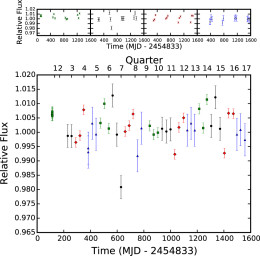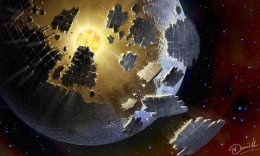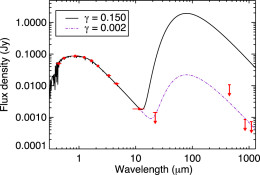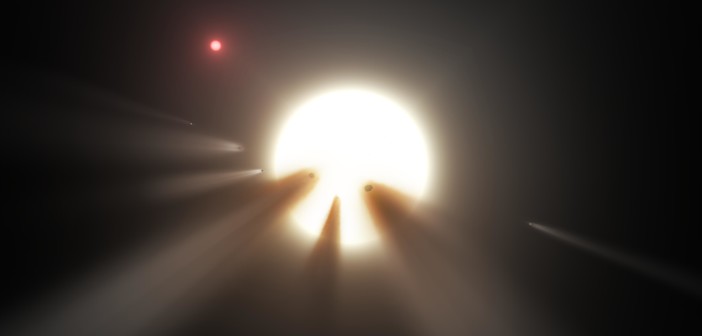
Photometric time series for a neighboring star that’s 25” NNW of Boyajian’s Star. No significant long-term dimming is seen — which constrains the size of potential material obscuring Boyajian’s Star. [Wright et al. 2016/Benjamin Montet]
An Unusual Light Curve
Earlier this year, astronomer Tabetha Boyajian reported on the unusual light curve of the star KIC 8462852. This star, now nicknamed “Tabby’s Star” or “Boyajian’s Star”, shows unusual dips on day-long timescales that are too large to be explained by planet transits or similar phenomena.
In addition to these short dips in luminosity, recent observations have also indicated that the star has faded by roughly 20% over the past hundred years. What could be causing both the short-term dips in the star’s light and the long-term dimming over a century?

Could the dimming be caused by an ‘alien megastructure’ built by an extraterrestrial civilization? The authors find that a spherical structure is very unlikely. [Danielle Futselaar/SETI International]
Alien Megastructures? Or Another Explanation?
Boyajian’s Star was vaulted into the media spotlight when astronomer Jason Wright (Pennsylvania State University and University of California, Berkeley) proposed that its unusual light curve could potentially be explained by a surrounding megastructure built by an extraterrestrial civilization.
Now Wright is back with co-author Steinn Sigurd̵sson (Pennsylvania State University). In a new study, Wright and Sigurd̵sson analyze an extensive list of explanations for the puzzling apparent behavior of Boyajian’s Star, based on our latest knowledge about this strange object.
The Realm of Possibilities
Here are just a few possible causes of Boyajian’s Star’s dimming, as well as the authors’ assessment of their plausibility. For the full list, see the authors’ original article, or check out Wright’s own summary of the article here!
- Pulsations, polar spots, and other stellar variability: unlikely
The authors show that the variety of timescales observed for dimming events make scenarios involving stellar variations unlikely. - Circumstellar material: unlikely
Material orbiting the star (like comets) would explain some of the light-curve dips, but it can’t explain the long-term dimming observed. - Post-merger return to normal: unclear
Perhaps Boyajian’s Star recently merged with a brown dwarf or other star? Now it could be gradually dimming as it returns to its normal brightness, and restructuring of the star’s material could cause the short-term dips. Though this scenario is possible, the timescales for the brightness changes are shorter than we would expect. - Artificial structures: unclear
Spherical swarms of structures would intercept the star’s light and re-radiate it in infrared. Since long-wavelength observations have found no evidence of such radiation, the authors declare spherical geometries to be unlikely. Other structure geometries can’t yet be ruled out, though. - Small-scale interstellar medium (ISM) structure: plausible
Small-scale density variations in the ISM between us and Boyajian’s Star could cause the dimming we observe, but the fact that nearby stars don’t show similar dimming sets tight limits on the size of such ISM clumps.

Spectral energy distribution of Boyajian’s Star. The upper-limit arrows on the right-hand side indicate that big clouds of megastructures are unlikely, because we would detect their heat as they re-radiate the star’s light in infrared. [Wright et al. 2016]
Looking to the Future
Of the possible locations for the source of the dimming, Wright and Sigurd̵sson deem the interstellar space between us and Boyajian’s Star to be the most likely culprit. They identify several future lines of research that could help us further eliminate possibilities, however, including a study of the ISM toward Boyajian’s Star, a hunt for similar variations in stars near in the sky to Boyajian’s Star, and infrared observation of the star with JWST to search for heat signatures.
Citation
Jason T. Wright and Steinn Sigurd̵sson 2016 ApJ 829 L3. doi:10.3847/2041-8205/829/1/L3

9 Comments
Pingback: more on Boyajian's Star (the star formerly known as Tabby's)
Pingback: Ces chercheurs pensent avoir résolu le problème de l’étoile de Tabby, la plus mystérieuse de l’univers – Presse et Actualité – Revue de Presse Généraliste
Pingback: More Unusual Light Curves from Kepler
Pingback: Es geht abwärts mit dem seltsamsten Stern im All | Skyweek Zwei Punkt Null
Pingback: Another Possibility for Boyajian’s Star
Pingback: Are There More Stars Like Boyajian's Star? – Sky & Telescope | SPACE FORCE
Pingback: Are There More Stars Like Boyajian’s Star? – Hamilton County Weather
Pingback: Are There More Stars Like Boyajian’s Star? – Dinezh.com
Pingback: Are There More Stars Like Boyajian’s Star?